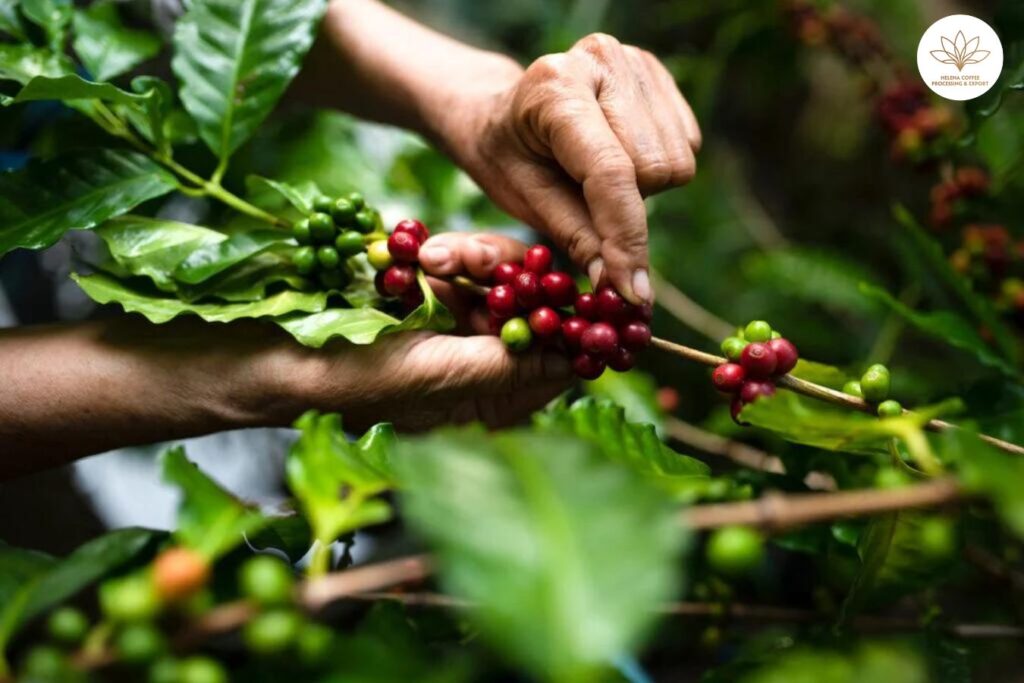The Phenomenon Of Fruit Loss On Coffee Trees: After the flower has been pollinated, the coffee fruit forms and develops quite quickly. However, after 1 year of bearing the fruit, the coffee tree has stored a large amount of nutrients in the fruit and seeds. Harvesting fruit also means removing a large amount of organic matter and nutrients from the tree, causing the tree to become depleted, so when entering the new crop, the amount of nutrients to feed the tree and the fruit on the coffee tree is reduced. the shortage is quite large. If we do not promptly add the necessary nutrients to the tree, the coffee will become exhausted, the phenomenon of fruit drop will begin to appear and the yield of the next crop will decrease significantly.
Causes of fruit drop on coffee trees
If in the early stages of the coffee berry’s development, the phenomenon of young fruit falling is often due to poor pollination, pests or harsh weather, then in the middle and late stages, the phenomenon of fruit falling is often due to a deficiency or loss. caused by nutritional balance. This means not fertilizing enough, or fertilizing enough but not properly balanced.
Thus, for coffee trees, balancing and supplementing nutrients for the tree throughout the cultivation process is extremely necessary. Applying NPK fertilizer to provide nutrition right from the time of making branches and buds is very important. It ensures plants have enough nutrition and growth.
However, according to research results of scientists, during the flowering and fruit development stages, the starch and nutrient content in the leaves decreases and this is often accompanied by the phenomenon of fruit drop due to deficiency. nutrition.
Thus, it is necessary to increase fertilization and nutritional supplementation promptly and adequately, especially during the period of fruit formation and development in order to limit the rate of fruit loss and increase productivity and quality of coffee trees. At that time, the process of synthesizing nutrients in the soil of coffee plants is often slow, so an effective solution to overcome this is to supplement nutrients for coffee plants with foliar fertilizers. Because foliar fertilizer is not only quickly absorbed by plants, it also provides timely nutrients to help plants get adequate nutrition as well as essential trace elements for plants such as Manganese, copper, magnesium… contributing to stimulating leaf growth. suitable, stimulates flowering and fruiting. When the coffee tree is fully nutritious, has strong leaves, long stems, and strong beans, it will reduce the rate of fruit drop and maintain coffee yield.
Prevent fruit drop on coffee trees with foliar fertilizer
According to experts, foliar fertilizers contain natural nitro benzene and hydrolyzed, strongly activated proteins. When spraying foliar fertilizer on coffee plants, it will provide nutrients to nourish the fruit and seeds, stimulate strong leaf photosynthesis and synthesize organic matter to nourish the fruit and seeds. In addition, foliar fertilizer also stimulates roots to take nutrients from the soil to supply to plants and reduces fertilizer costs, reducing the rate of coffee berry loss due to lack of nutrients.
Using Boom flower-n foliar fertilizer:
- If spraying with a hand sprayer, use 1.3 – 1.5 liters/ha each time for a 16 liter tank.
- If spraying with a mixer, mix 1.5 – 2 liters with 600-800 liters of water for 1 hectare.
When spraying foliar fertilizer on coffee plants during the flower bud differentiation stage, it will stimulate the flowers to bloom simultaneously and increase the fruit-setting rate right from the beginning. However, the important thing is that foliar fertilizer can also be combined with many types of pesticides to spray at the same time, this is an advantage that reduces costs and work hours when preventing pests and diseases on coffee plants. fruit growing stage, because the phenomenon of fruit drop on coffee trees is not only due to nutritional imbalance, but also another cause is harmful diseases such as anthracnose, pink fungus, and rust on coffee trees.
To prevent and reduce the rate of fruit loss caused by harmful pests and diseases, people need to detect it early and prevent:
- For anthracnose, use the fungicide calvin 50SC
- For leaf spot rust, use the fungicide Tilt super 300EC
- For pink fungus disease that often appears during the rainy season, use Bonanza 100 SL or Validan 3DD or 5DD.
Note: read instructions carefully before use
Thus, when robusta coffee berries begin to rapidly increase in size, at the same time there is a rapid increase in coffee buds and branches, so it is necessary to provide adequate nutrition and regulate light to suit the reproductive status. management of the tree, so that the tree can both grow good fruit and create a full set of healthy branches for the next year. Therefore, in addition to adding appropriate nutrients, it is necessary to clean the fields so that coffee plants can photosynthesize, receive light to grow well, and at the same time manage diseases well on plants. When the coffee tree is healthy, it also means it has good resistance to diseases as well as erratic changes in weather for high productivity.
FAQS :

